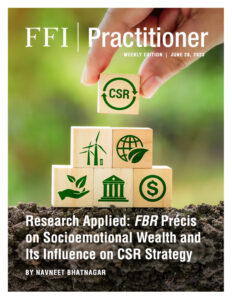
View this edition in our enhanced digital edition format with supporting visual insight and information.
Thank you to this week’s contributor, Navneet Bhatnagar, for sharing his précis of “Examining Heterogeneous Configurations of Socioemotional Wealth in Family Firms through the Formalization of Corporate Social Responsibility Strategy” – an article that appears in the June 2023 issue of FBR. In the précis, Navneet provides a summary of the research and key findings, as well as exploring the practical implications of the research for families, advisors, and researchers in the field.
Socioemotional wealth (SEW) is the non-financial value embedded in a family firm. SEW is the affective endowment built due to family involvement in business and is a key factor that distinguishes family firms from non-family firms. While non-family firms may primarily aim to maximize financial value, family businesses tend to consider both financial value and SEW preservation in their strategic decision-making process. Though family firms employ different dimensions of SEW while making their strategic choices, scholarly research has mainly used ‘family involvement’ as a unidimensional measure for SEW. In this study, family business scholars Josh Wei-Jun Hsueh, Alfredo De Massis, and Luis Gomez-Mejia analyze primary data from 186 Italian family firms to examine how the multidimensionality of SEW explains family firm’s strategy. Taking the example of a family firm’s corporate social responsibility (CSR) strategy, the authors employ psychometric measures to explain how different configurations of SEW dimensions shape the extent of formalization of the firm’s CSR strategy.
SEW Dimensions, CSR Strategy, and Its Formalization
The SEW construct encompasses various dimensions, including family control, family identity, binding social ties, emotional attachment, and the preservation of the family’s dynasty. These dimensions interact in complex ways to determine a family firm’s strategy. To address this complexity, the article advocates for a configurational approach involving different combinations of SEW dimensions and then examining their effect on a firm’s strategic outcomes.
The study takes CSR strategy as an example to understand the effect of SEW on strategy. CSR strategy denotes how a firm addresses social issues, such as environmental protection or discrimination against minority groups. CSR strategy lends well to the study as it involves cross-level implementation that includes several levels of decision-making:
- Firm-level decisions, such as creating an organizational structure,
- Individual or team-level decisions, such as engaging targeted stakeholders and employees, or
- Macro-level decisions, such as working with institutions for regulatory compliance.
Firms tend to gradually formalize their CSR strategy for successful multi-level implementation.
Family firms can benefit from the formalization of CSR strategy on account of improved monitoring, implementation, and communication with external stakeholders. Despite these benefits, there are mixed findings in the literature about the relationship between CSR formalization and SEW. The authors attribute this to the narrow sense in which SEW is measured (such as in terms of “family ownership” or “generations involved”), while several key dimensions such as identification, social ties, and emotional attachment are either ignored or downplayed.
Taking into account the multidimensionality of SEW, the authors performed a qualitative comparative analysis to understand the effect of SEW on a family firm’s CSR strategy. In addition to family involvement, the authors also considered other SEW dimensions, including family identification, family ties, emotional attachment, and dynastic renewal. Readers interested in a deeper understanding of the analytical method employed in the study may refer to the methodology section of the article.
Key Findings of the Study
The study identified two configurations of SEW dimensions that led to the formalization of CSR strategy and four other configurations that resulted in the non-formalization of CSR strategy. These configurations are characterized as the following:
Configurations That Lead to Formalization
- Renewal of the Firm Dynasty: In this configuration, the family owns the business but has limited involvement in governance or management. They aim to maintain family control over the business with support from nonfamily stakeholders through the formalization of stakeholder communication.
- Renewal of Family Dynasty: The owner family aims to sustain the family dynasty with its own resources and maintains a positive identity. The owners see the opportunity to ingrain family values through formalization.
Configurations That Lead to Non-Formalization
- Guarding the Past Family Legacy: It has a strong firm structure, including the board, ownership, and management. The owner families give less attention to family continuity or formalization but use present involvement in the business to guard past family legacy.
- Strengthening the Coalition: The family is involved in the firm but not very strongly. Members involved in the business form this coalition, but it is not yet the dominant coalition in the firm. Members are more focused on improving communication within the coalition than formalizing it with nonfamily stakeholders.
- Bathing in the Glory of the Past Family Dynasty: The owner family has close ties and strong emotional bonding, but backward-looking reference and no motivation for formalized communication.
- Retaining Only the Family Relic: The owner family has a very weak SEW, marked by the absence of emotional bonding, family involvement, identity, and a forward reference to renewing the family firm dynasty.
More significantly, the findings indicate that the owner family’s temporal focus, i.e., whether they are forward-looking or backward-looking, plays a crucial role in determining the formalization decision of CSR strategies. When the family has a forward-looking SEW (when succession and involvement/control in the future is the priority), it formalizes the strategy to renew the dynasty. Conversely, a backward-looking SEW (when past legacy is the priority) without consideration of dynastic renewal leads to the adoption of an informal CSR approach to preserve family legacies. Therefore, it is how the owner family prioritizes and configures SEW dimensions that determine its strategic decisions and outcomes.
Readers can further explore the discussion section of the paper for a deeper understanding of different SEW configurations and the propositions presented by the authors.
Implications of the Study:
For Research
- The article contributes to the theoretical understanding of the SEW construct by elucidating the interrelations among its dimensions.
- It also advances the study of family firm heterogeneity by showcasing how different SEW dimensions interact to determine various outcomes and how the temporal focus of the firm shapes its strategic choices.
- Methodologically, the configurational approach offers a more comprehensive understanding of family business behaviors beyond the simplistic examination of family involvement.
For Family Firms and External Stakeholders
- When family firms benchmark their performance with other family firms, it is important to realize that strategic choices and outcomes are likely to be driven by that firm’s unique configuration of SEW considerations.
- When owner-managers intend to learn from other similar family firms before investing in a new strategy, such as formalizing CSR communication with external stakeholders, it is critical to understand the temporal focus (forward- or backward-looking) and the strategic motivation of other family firms.
- Understanding the factors that influence family firms’ adoption of CSR strategies has practical implications for regulators, investors, and other stakeholders who monitor and assess these strategies.
- By considering multiple SEW dimensions and the family’s temporal focus, stakeholders can better comprehend why family firms choose specific strategies and respond differently to their needs.
For Advisors
- While assessing the role of SEW in shaping a family firm’s strategic choices, advisors must take a comprehensive view of SEW and assess different configurations of SEW dimensions that can distinctly affect a firm’s strategic decisions.
- Advisors need to recognize and be cautious about the pitfalls in family firm benchmarking. It is important to bear in mind that seemingly similar family firms can vary in their temporal focus and approach to SEW. Depending on whether they are future-oriented (dynastic) or backward-looking (legacy preservation-oriented), family firms are likely to make distinct strategic choices.
About the Contributor

Navneet Bhatnagar, PhD, ACFBA is Assistant Professor (Strategic Management) at the Indian Institute of Management Raipur, India, and the Executive Committee Vice Chair for the FFI Asian Study Circle Virtual Study Group. Navneet is the 2020 recipient of the Fitzpatrick & Francis Family Business Continuity Foundation GEN Scholarship. Previously, he was the Associate Director at the Thomas Schmidheiny Centre for Family Enterprise, Indian School of Business, Hyderabad, India. He can be reached at nbhatnagar@iimraipur.ac.in.

View this edition in our enhanced digital edition format with supporting visual insight and information.





